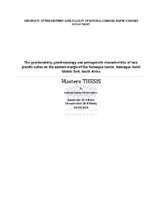| dc.description.abstract | The group of granites on the eastern margin of the Mesoproterozoic Namaqua sector of the polydeformed and highly metamorphosed Namaqua-Natal Province of southern Africa is known as the Keimoes Suite. The suite includes mixtures of diverse rock types not belonging to a single intrusive series and so it should be subdivided into more than one intrusive suite. The exact definition, extent, distribution and petrogenesis of these granites have been poorly defined in the past, with various authors defining the suite differently due to the lack of proper geochronology and geochemical data. The exact contact between the Namaqua sector and Kaapvaal Craton together with the role of the suite to the Namaqua tectonic evolution is still unclear. The granites of the Keimoes Suite are thought to mark the contact between the Namaqua sector and the Kaapvaal Craton. This study seeks to address the above mentioned problems by making use of new geochronology, isotope, major and trace element geochemistry together with petrography. The granites of the Keimoes Suite were previously grouped based on their degree of deformation. The geochronology, undertaken as part of this study, has proven that this classification is unfounded. The degree of foliation in these granites appears to be largely controlled by the abundance of platy minerals, such as biotite and muscovite, together with the intrusion mechanism, with deformational processes, such as shearing, playing a secondary role. The geochronology, together with geochemistry has helped to redefine the previously defined Keimoes Suite so that two well defined separate suites are recognized
and the third is poorly defined due to lack of more samples of that age group. The new classification or grouping of the granites of the eastern Namaqua sector allows a more detailed examination of the tectonic evolution of this region. A member of the 1225 to 1200 Ma early syn-tectonic granites, the Josling Granite, shows a strongly developed foliation and was derived from a depleted source with a relatively low continental crustal component. This granite intruded during the time of arc accretion, and is associated with, and partly responsible for the D₁ deformation and M₁ metamorphism recognized in most of the rocks of the eastern terranes of the Namaqua sector. In terms of age, the syn-tectonic granites of the Augrabies Suite extend from 1200 to 1120 Ma and were largely derived from depleted sources with variable but more substantial amounts of continental crustal components as compared to the early syn-tectonic granite. The granites of this suite intruded during the period of peak D₂ deformation with peak magmatism between 1180 - 1135 Ma, and particularly around 1150 Ma, during the peak of
metamorphism (M₂) caused by, and associated with these voluminous intrusions. The Keimoes Suite can now be defined as comprising granites of late- to post-tectonic age relative to the 1.2 - 1.08 Ga Namaquan Orogeny with magmatism occurring on the western side of the Kaapvaal Craton. The 1116 to 1066 Ma Keimoes Suite intruded during the stage of the Namaquan Orogeny in which there was continued indentation of the Kaapvaal Craton into the Namaqua sector with wrenching and shearing causing the development of rifting into which the granites intruded. The Keimoes Suite granites were derived from continental crustal sources and incorporated varying degrees of depleted source components. The intrusives and extrusives of this age occured after the main collisional event between the Namaqua Sector and the Kaapvaal Craton and are associated with the D₃ deformational event, imparting the thermal conditions leading to the M₃ metamorphic event of the rocks within both the Kakamas and Areachap Terranes. The suites mark the suture between the Archean Kaapvaal Craton and the Proterozoic Namaqua sector. The compositions of the granites of the individual suites were mainly controlled by the source with the degree of partial melting exerting a major control. The proportion of entrained peritectic assemblages
and accessory minerals played a major role in controlling the compositions of the granites, particularly those of the trace elements. Variations within the compositions of the same suite are due to source heterogeneities. Generally, fractionation processes played a secondary role in influencing the composition of the granites. | en_US |

